Mini-public II - Findings
Findings of REELER's Mini-public II
Event summary
REELER's second Mini-Public was at The Workers' Museum in Copenhagen on 27 November, 2018.
The event was concerned with the topic of meaningful work in relation to automation and robot technology and needed competences. There were two main questions framing the event:
- Who is most responsible for securing a meaningful work life with robots?
- What type of competences will we need in the future?
Politicians, researchers, industry and labour union representatives presented their views on the topic in the light of fresh research results from REELER. Following each presentation, the audience was asked to submit an answer to a question related to each talk.
Speakers
Cathrine Hasse
The mini-public opened with a presentation by REELER coordinator, Cathrine Hasse, who presented selected REELER results related to our investigations into how industrial and service robots seem to influence the work life of the people collaborating or expected to collaborate with these robots.
While bringing attention to the fact that more jobs seem to be created than eliminated by robot technology, Cathrine stressed the disparity between the requirements of the jobs created and the skills of the people being replaced. Moreover, she presented results of the REELER research that point to a potential negative impact on collegiality and social life at the workplace as well as prosperity of the individual at workplaces where robot technology has been or are about to be implemented. Cathrine ended her talk by asking the audience to once again reflect on the same two questions above.
Mette Fjord Sørensen

The first invited speaker to present was Mette Fjord Sørensen, representing The Confederation of Danish Industry (DI). Mette addressed the fears and concerns raised by informants in REELER's research. While acknowledging these fears, Mette focused on the need for automation in industry to keep up with competitors abroad, and pointed to the upsides of automation - more, better, higher-paid, less physically straining jobs. Mette ended her presentation by asking participants to consider the following statement: "Increased automation is a zero-sum game in relation to the employee's jobs".
Sophie Hæstorp Andersen

The second speaker was Sophie Hæstorp Andersen, chairman of the Regional Council of the Capitol Region of Denmark and previous member of Parliament, who talked about the need for technological literacy as the interplay increases between robot solutions/technology and humans. Mette ended her presentation by asking the audience to reflect over which areas of their present work might be taken over by a robot or AI.
Ida Auken

The third speaker was Ida Auken, member of Parliament for the Danish Social Liberal Party and co-founder of the SIRI commission. Ida’s presentation was on the pitfalls and upsides of automation and AI. On the topic of work life, Ida argued that attempts at implementing robot technology (and AI) in the public sector should not be done as an exercise in efficiency, but rather with the goal of improving the overall service level of the public sector, since the former risks alienating both public sector employees as well as citizens. Ida ended her talk by asking the participants: "What words do you associate with robots in the labor market?"
Following the three presentations, Mette, Sophie and Ida took questions from the audience.
Morten Smistrup

The first presenter for the second part of the day, Morten Smistrup, from The Danish Confederation of Trade Unions (LO) started his talk by stating that many professions had already been lost to automation or other developments - and that this might be more positive than we usually speak of. He pointed to the possible upsides of automation which might ease the burdens of manual laborers who would otherwise unfortunately wear themselves out halfway through their lives. He also criticized the abstract conception of 21st century skills, and argued instead for a concrete foundation of skills in particular professions. To conclude, Morten asked the audience to consider: “How big is the risk that social strife will undermine the gains that might be earned from taking advantage of robots/AI given the current societal conditions?”
Jesper Balslev

Second presenter was Jesper Balslev, a lecturer and PhD-fellow at the Copenhagen School of Design and Technology (KEA). Jesper’s presentation focused on the possibility of preserving what is distinctly human in the face of automation. He discussed the role of machine learning software in the development of cultural products and argued that the domain of creativity proper would be forever closed for robots and AI. Jesper concluded by asking the audience: “Should research funds be dedicated to research on job-creating technologies?”
Bent Greve

Bent Greve, professor of labour market research at Roskilde University Center (RUC), was the third presenter. Bent’s primary focus was the question of how to secure workers' possibility to develop competences matching changing in the labour market. Bent stressed how workers are not all necessarily capable of continual upskilling but may need to change professions, and that the labour systems should support this transition. To this end, Bent proposed that a fund be established which would allow individual workers to reskill when the need arises. In this vein, Bent ended by asking: “Should retraining/reskilling be both a duty and right?”
Jacob Rubæk Holm

The final speaker was Jacob Rubæk Holm, associate professor at the University of Aalborg. Jacob’s talk focused on the necessity of reskilling labor in a changing economy, and the pitfalls of failing to leverage automation and reskilling, which might further expand the gap between rich and poor. While Jacob placed the responsibility of reskilling with the individual worker, he emphasized that workers could not lift the burden of reskilling alone and would need the help of both the employer and society at large. He ended his talk by asking participants to evaluate the statement: “To the degree that there is a trade-off between a meaningful work-life and economic growth, should the meaningful work life have priority?”
The event ended with a final panel discussion with Jakob, Bent, Jesper and Morten, with questions from the audience.
Audience Responses
Attendees at the Mini-Public were invited to participate through voting and responding to a number of questions on a Mentimenter presentation. Here you can scroll through the entirety of the Mentimeter votes. Below we go through each one separately. For each of these, the number of people who responded is indicated at the bottom right.
Question 1: Which occupational category best describes you?
 First we asked the participents to name the occupational category most suitable for them. These are, from left to right:
First we asked the participents to name the occupational category most suitable for them. These are, from left to right:
1. In red: Consultant.
2. In green: Employer.
3. In light blue: Self employed.
4. In Purple: Wage worker.
The purpose of this question was to get an overview of the occupations of the the participants, while also providing REELER with categories for segmenting the following questions.
Question 2, 4, 9, and 14: Who is most responsible for securing a meaningful work life with robots?
This question was first of the two central questions of the event. The question was posed by REELER four times during the event:
1. When the participants had all arrived, before any of the presentations.
2. After the first presentation by REELER coordinator, Cathrine Hasse.
3. After the first coffee break, before the first panel debate.
4. After the conclusion of the final panel debate – immediately prior to the end of the event.
The first three will be compared in this section. The fourth stands out since some participants had left before the final questions, and others had joined following the lunch break, which makes the composition of voters different from the first three. However, it is worth noting here that the distribution of votes in the final votes resembles the first three.
For future reference, the participants were asked chose between four different options the first two times, and five in the final two. These were:
1. In green: Me.
2. In light blue: The employer.
3. In yellow: Education.
4. In dark blue: Union(s).
5. In red: Politicians.
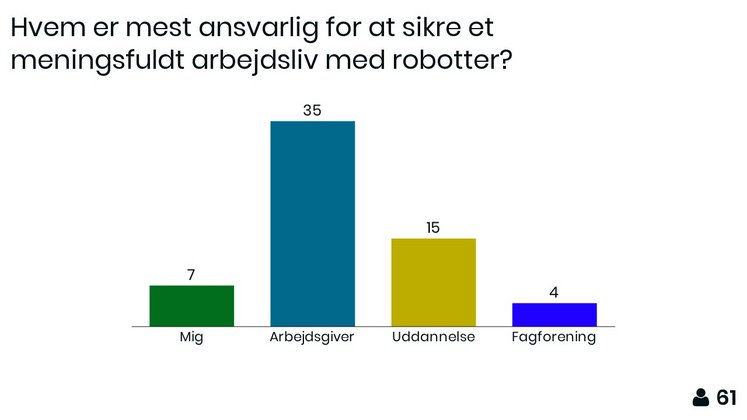
In the first vote a strong majority thought that the employers were most responsible for securing a meaningful work life with robots. This remained the dominant trend throughout the four votes, however, it was not nearly as strong towards the end.
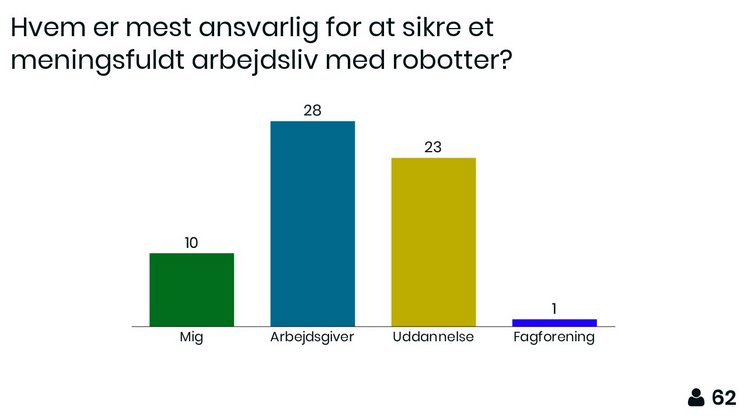 By the second vote this majority had already declined significantly. Following Cathrine’s presentation, a significant portion shifted their vote from the employer to education, and only one person voted for the unions. The number of people who thought it was the responsibility of each individual secure a meaningful work life rose slightly as well.
By the second vote this majority had already declined significantly. Following Cathrine’s presentation, a significant portion shifted their vote from the employer to education, and only one person voted for the unions. The number of people who thought it was the responsibility of each individual secure a meaningful work life rose slightly as well.
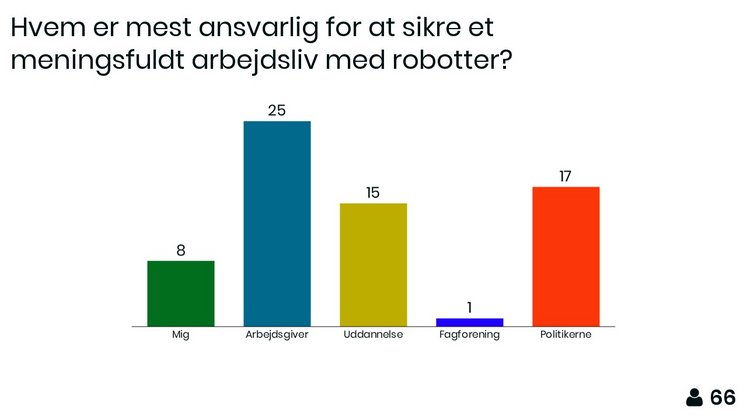
The third vote sets itself apart by from 1 and 2 by including politicians as a possible answer. Politicians were included here by popular demand; participants addressed REELER to ask for the category to be included. These results suggest that a significant majority agreed with this decision, as most of the votes for politicians was moved from education, which implies that approximately half of the people who voted for education in the second vote might have put their vote there for lack of a better alternative.
From vote 1 to 3 the top category, employer, has fallen from 35 to 25 despite the number of respondents rising from 61 to 66. This corresponds to a fall from 57.3% to 37.9%. These are the percentages corresponding to the responses of the third vote:
1. Employer (37.9%)
2. Politicians (25.8%)
3. Education (22.7%).
Expressing the top three catogories in terms of percentages allows for a comparison with the final vote.
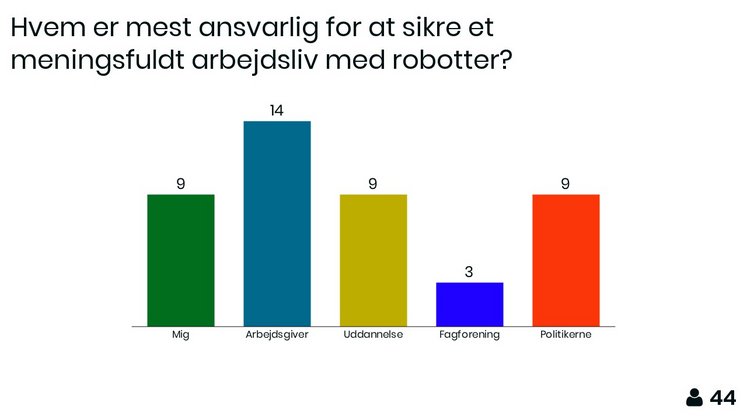
The final vote is the least reliable of the four since a significant number of the original participants had left and others had joined. All in all the amount of respondents fell from a high of 66 to 44. Of note is the fact that the amount of people, who thought that the individual was personally most responsible for securing a meaningful work life remained constant throughout the event and ended as a shared second. When the top four are expressed in the percentages we get the following distribution:
1. Employers (31.8%)
2-4. Education; Politicians; Me (20.5% each).
Question 3, 5, and 15: What type of competences will we need in the future?

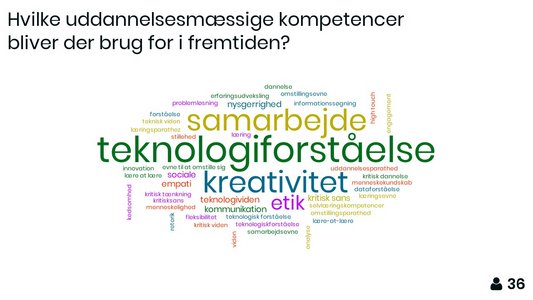

The question: "What type of competences will we be needing in the future?" was the second of the two central questions of the event. The question was posed by REELER three times during the event:
1. When the participants had all arrived, before any of the presentations.
2. After the first presentation by REELER coordinator, Cathrine Hasse.
3. After the conclusion of the final panel debate – immediately prior to the end of the event.
The first two will be compared, since the same participants voted on both, and the third vote will be presented as well. However, as with the first question, the third vote stands out in that the composition of participants differs significantly from the first two. This means that the comparison with these is less reliable.

As mentioned in the beginning the first vote was taken prior to any presentations and can thus be considered a sort of baseline. Here is a translation of the most significant (biggest) words:
1. Teknologiforståelse: Technological literacy
2. Programmering: Programming.
3. Kreativitet: Creativity.
4. Kritisk sans: Critical thinking.
5. Samarbejde: Cooperation.
6/7: Viden: Knowledge / Etik: Ethics.
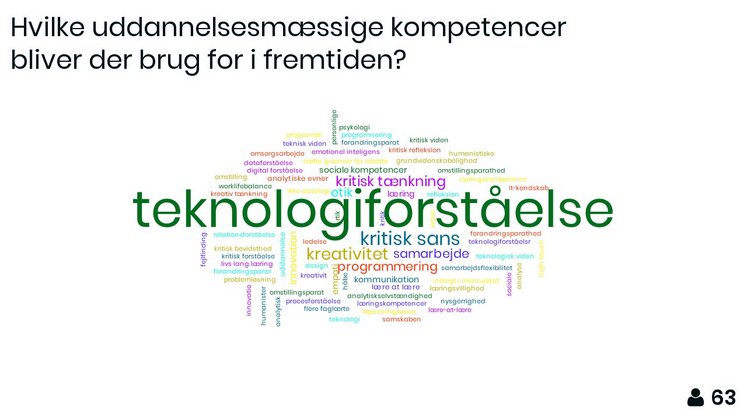
The second vote:
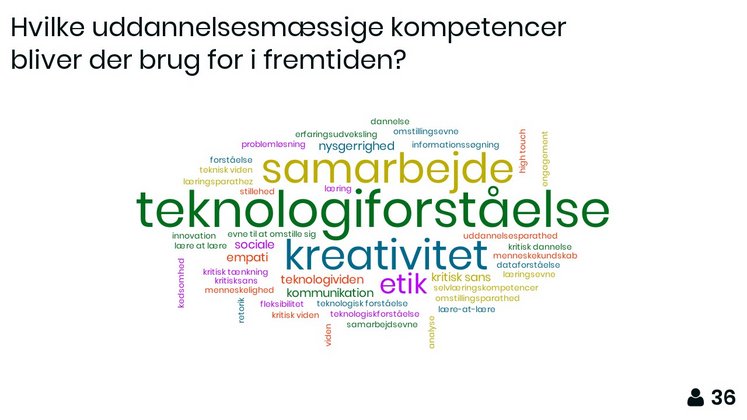
Question 6: Automation is a zero-sum game in relation to workers' jobs.
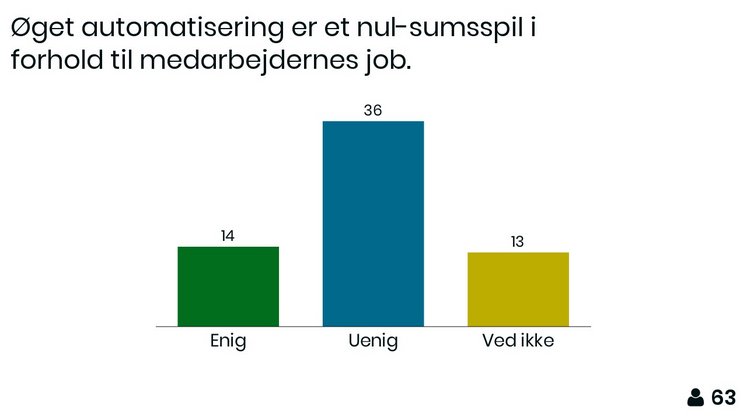 Mette Fjord Sørensen's presented the audience with the following statement: "Automation is a zero-sum game i relation to the workers' jobs". Participants had the following options for evaluating the statement:
Mette Fjord Sørensen's presented the audience with the following statement: "Automation is a zero-sum game i relation to the workers' jobs". Participants had the following options for evaluating the statement:
1. In green: Agree.
2. In blue: Disagree.
3. In yellow: Don't know.
Question 7: Which of your tasks at work could be replaced by some advanced technology in the future?
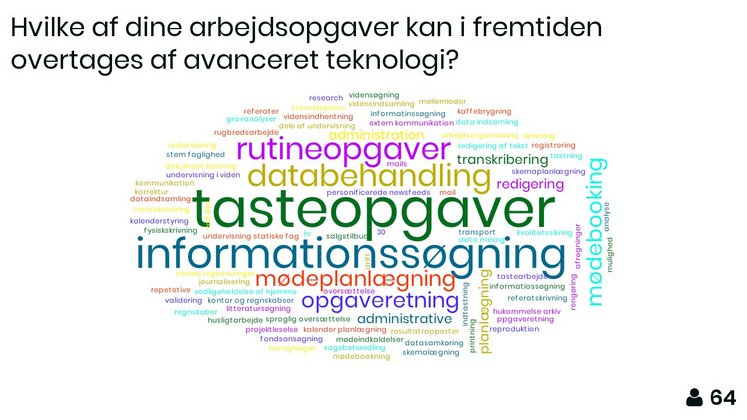
As a response to Sophie Hæstorp Andersen's question, the audience were asked to type in three of their work tasks each that they thought could be automated.
The bigger the words, the more recurring the words were in the answers. The four most recurring words were:
1. Tasteopgaver: Typing tasks.
2. Informationsøgning: Information search.
3. Databehandling: Data management.
4. Rutineopgaver: Routine tasks.
That the top four words revolve around an office theme may to some extent reflect the composition of the participants – intermediaries between robot developers and robot users, rather than manual workers. The top four tasks mentioned here are of a sort which, prima facie, seems easily automatable in that they can be conceptualized as a particular kind of algorithm. In this regard it is interesting to note the 5th and 6th most mentioned tasks:
5: Mødeplanlægning: Planning meetings.
6: Opgaveretning: Assignment grading.
While number 5 seems to follow the pattern of 1-4, assignment grading stands out. While grading assignments is something that teachers routinely do, it does not necessarily follow an algorithm, but seems to require some skills that have traditionally fallen outside the scope of the automatable, especially within the humanities; e.g., interpretation, 'deep' analysis and understanding metaphors.
Question 8: What words do you associate with robots in the labor market?
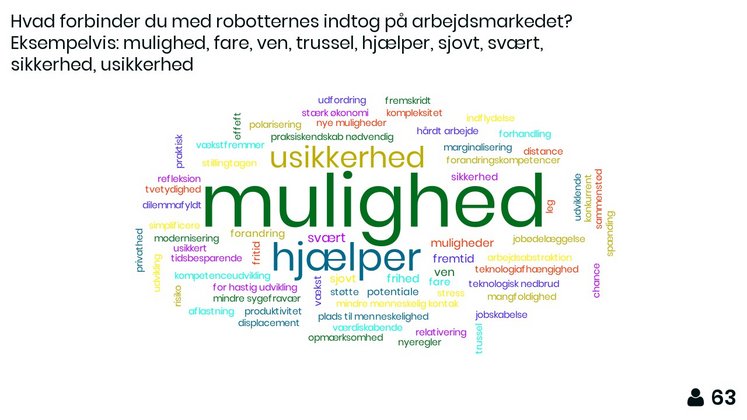
Ida Auken asked the audience to each write 5 words that they connected with robots entering the labor market. Three words, in particular, stood out. From largest to smallest these are:
1. Mulighed: Possibility.
2. Hjælper: Helper.
3. Usikkerhed: Uncertainty.
Possibility stood out by far among the other words and contains positive connotations suggestive of a general optimism about the future of work – think, conversely, about the term 'risk', which is entirely absent from the word cloud. This is further corroborated by the second largest word, 'helper', which is also positive – again, one could have imagined a gloomier term; competitor (for a job), for instance.
Choosing the word helper is interesting here for another reason, since it implies a clear hierarchy, which awards primacy to humans and a secondary, supportive role to the robot. Participants don't imagine themselves being subservient to robots, but rather conceive of these as enhancing their practices.
As it stands, the third largest word, 'uncertainty' is the only word that can readily be interpreted as having negative meaning. It could be considered as a contrast to the biggest word, 'possibility', in that it entails a somewhat negative outlook on the future. Yet, it is worth noting that the term is can actually point to a suspension of judgment; it can be foreboding, but might signal more of a cautious attitude than outright aversion.
The general tone of the word cloud is in keeping with the tone of question 6 in that it is overall positive.
Question 10: How big is the risk that social strife will undermine the possible gains from taking advantage of robots/AI given the current societal conditions?”

Morten Smistrup asked the audience to provide an estimate of the risk that social strife would undermine the benefits of using AI and robots. The audience was asked to choose from the following options, from left to right:
1. In green: Very big.
2. In blue: Big.
3. In yellow: Small.
4. In purple: Very small.
This question was answered following his talk, which was nuanced and slightly optimistic in its view on the use of robots in manual labour-settings. At first glance the distribution might appear to be approximately 50/50, but it is considerably skewed with 15.7% more people estimating a big or very big risk of social strife undermining the gains of using robots/AI than those who estimate the risk to be small or very small.
One the one hand, the result of this poll may seem hard to reconcile with the overall tendency of the previous questions that point to a generally optimistic view about robots in work place. Yet, on the other hand, it indicates precisely the complexity of this field as is often times touched upon in REELER's empirical data. Though robots may be seen as potentially positive with regards to efficiency and relief of hard and tedious work, their impact on social and economic cohesion appear more dubious.
Question 11: Should research funds be allocated for research on job-creating technologies?
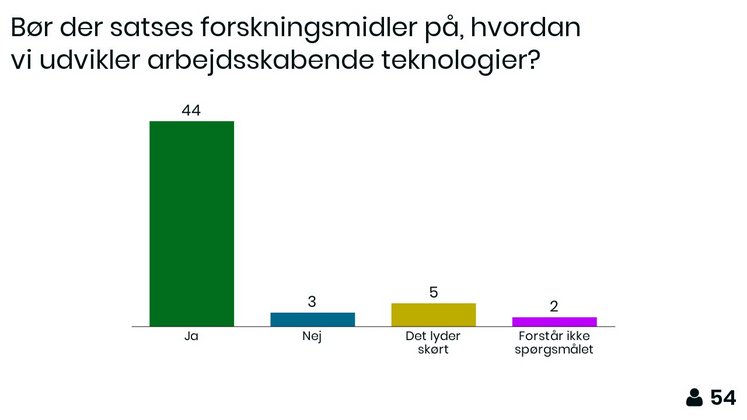
Jesper Balslev asked participants to indicate whether they thought research funds should be allocated to research on work-creating technologies. Participants were asked to choose from the following options:
1. In green: Yes.
2. In blue: No.
3. In yellow: That sounds silly.
4. In purple: I don’t understand the question.
The participants voted overwhelmingly in favor of yes.
Question 12: Should retraining/reskilling be both a duty and a right?”

Professor Bent Greve asked the audience to indicate whether or not they thought retraining/reskilling should be an individual right – as well as a requirement - for each worker. The participants were asked to choose between the following options:
1. In green: Yes.
2. In blue: No.
3. In yellow: Maybe.
4. No colour: Don’t know.
The question points to the connection between rights and duties, a connection which has existed for more than a century within the Danish labour movements. This connection has often been brought to the fore using the slogan: "Gør din pligt og kræv din ret" (In English: Do you duty and claim your right).
The framing of the question also serves to underscore the overall point of his presentation. While the ultimate responsibility for securing a meaningful work life lies with the individual (i.e. it is a duty of the individual), it is a burden that individuals are unable to carry or lift on their own . That is, they have to be awarded the right of reskilling.
While the majority of the participants indicated that they agreed with the proposal, a significant minority could not decide either way.
Question 13: To the extent that there is a trade-off between a meaningful work-life and economic growth, should a meaningful work-life be the priority?
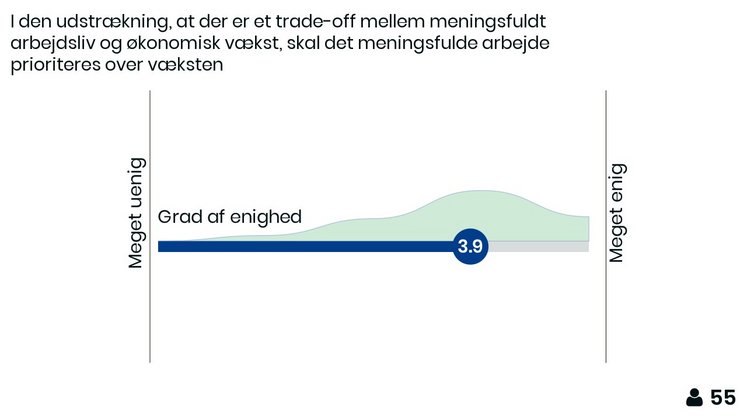
Jakob Rubæk Holm posed the final question from the presenters to the participants. He asked the participants to specify to which extent they agreed with the following statement: “To the extent that there is a trade-off between a meaningful work-life and economic growth, the meaningful work life should have priority” on a scale of 1 to 5. 5 indicating the highest degree of agreement, 1 the lowest.
3.9 was the average score of votes, and the distribution shows that very few participants expressed disagreement with the statement.
Interested? Read more here
Research-based REELER findings on robotics' influence on worklife
The project has interviewed more than 130 roboticists and affected stakeholders in 13 European countries, and our initial cross-case analysis of 10 different types of robots has identified a number of ethical issues and human needs in relation to robots entering human spaces and workplaces. This paper presents some of REELER’s anonymized ethnographic data relating to the topics of work, replacement, reskilling and relief.
The Impact of Automation on Employment: Just the Usual Structural Change?
Our REELER colleagues look at the displacement of labor across different sectors, painting a picture of labor shifts from 'sectors of application' to newly created, labor-intesive sectors. They conclude that we are looking at "the usual structural change" rather than "the end of work."
The Class Cage. Where Automation is taking us
In his book, Nicholas Carr takes a critical look at automation, arguing that it takes away rather than contributes to the good life. According to Carr, automation, instead of freeing us from monotonous work, actually causes us to lose crucial abilities central to a good life.
Human + Machine: Reimagining Work In the Age of AI
Daughtery and Wilson argue that neither humans nor machines are at their best on their own. Human + Machine invites us to rethink and redesign our work places so that they play to the strenghts of humans and machines respectively. A techno-optimists guide to understanding AI - what it means in our lives and how we can make the most of it.
What Skills Will You Need To Be Employable in 2030?
The MIT Technology Review provides a brief, easy to read redux of the NESTA/Oxford Martin School research collaboration, which look at skill gaps, the future of competencies and much more. There MIT TR lists the top 5 skills needed to be employable in 2030 - very abstract and removed from everyday praxis, these sorts of concept are a topic of discussion.
McKinsey's Automation and the Future of Work
McKinsey Global's website dedicated to their own research on the future of work and the impact of automation on the labor market. Covering a range of different topics: reskilling, displacement of labor, advancing women's equality, the future of african-americans on the labor market, and more.
Mentimeter data
If you are interested in accessing the mentimeter data yourself, you can do so here - either directly in your browser or as a download.